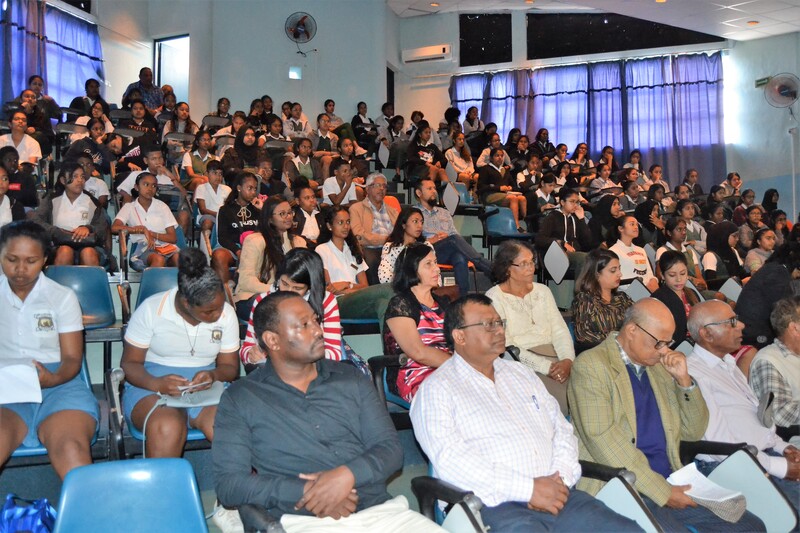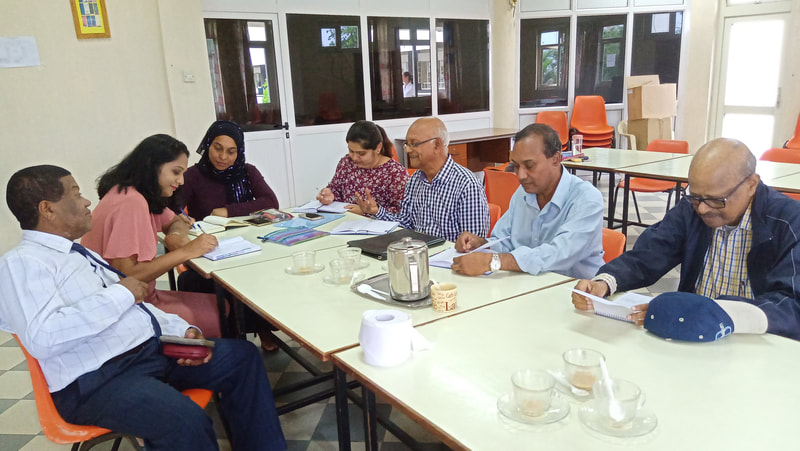Sandwatch initiated at Sir Leckraj Teelock State Secondary School
Sandwatch activities were successfully completed last year in two State Secondary schools (SSS) – France Boyer de la Giroday SSS (FBGSSS) at Blue Bay Public beach situated to the south East and La Gaullette SSS at La Prairie Public Beach in the south. Sponsored by Currimjee Foundation, the Association pour le Développement Durable (ADD) has been leading the process with the valuable support of the Ministry of Education, Tertiary Education, Science and Technology. A closing ceremony was held on 08 July 2019 at FBGSSS where the two schools presented their findings in the presence of about 125 participants comprising students and educators from the two schools, representatives of the Ministries of Education and Blue Economy; Currimjee Foundation, sandwatch sponsor; ADD members and other NGOs.
1.1 Preliminary arrangements Meetings were first held with SLTSSS and DRCSSS to brief the Rectors and Educators about Sandwatch and discuss the implementation process. The Rector and Educators of FBGSSS were also met to discuss how implementation could be improved on the basis of feedbacks obtained from participating students and educators last year. The decision taken included: Four in class activities in each school to introduce sandwatch to students and educators and train them on data entry in the UNESCO International database and four field sessions to collect data and information at the respective beaches.
1.2 First in-class session
The first activity took place at the end of January and beginning of February in the three schools. A power point presentation was made to introduce sandwatch and provide details on the benefits of participation and on activities expected during practical sessions. Observations and measurements to be made, on the various beach parameters including beach composition, erosion and accretion, water quality, waves and longshore current, beach debris and plants and animals, were elaborated. One of the 11 YouTube on Sandwatch, available on the Sandwatch Foundation website, was shown. The students were encouraged to watch the other YouTube to grasp better the concept of beach activities. A video clip of a song on climate change to enhance sensitization, in which 17 famous Mauritian artists participated, was also shown.
The in class sessions were opened to about 60 students of Grades 10 and 12 to enable a maximum number of students benefit from the presentation. However, outdoor sessions in the field would be limited to about 15 students of Grade 12 to allow focused attention on data collection as specified in the Sandwatch manual. The Grades 10 students would get the opportunity to participate more actively in Sandwatch implementation in two years time when they would be in Grade 12.
The students and educators appreciated well the interdisciplinary approach of Sandwatch. Though Sandwatch is science in action, emphasis was placed on how students with skills, aptitude and interest in arts, photography and public speaking would have the opportunity to develop further these qualities. They were further encouraged to get access to the Sandwatch manual on the Sandwatch website for more details in order to get themselves better prepared for subsequent activities.
It is envisaged to extend sandwatch to a school and a beach in the north next year to establish a complete network around Mauritius. Rodrigues, an island of the Republic of Mauritius, situated at about 600 km to the east of Mauritius is also being considered. The Commission of Environment has already been approached and the request is being processed by the Rodrigues Executive Council.
Sandwatch activities are also developing in Madagascar and Comoros. A “train the trainers” workshop is planned in March/April 2020 at Tulear. Staff from relevant Ministries/Institutions and students and educators from two schools in the region would benefit from the training to develop subsequently Sandwatch at the community and school levels. Two participants from Comoros are expected to attend. ADD is in contact with Seychelles Sandwatch group which is developing and strengthening Sandwatch in the country. It can be seen that Sandwatch is gathering momentum in the West Indian Ocean. ADD will contribute its part to ensure that this trend is maintained.
Acknowledgements:
ADD is especially thankful to the following companies, institutions and persons for the on-going success of the Sandwatch program: Ministry of Education, Tertiary Education, Science and Technology for ongoing support, Currimjee Foundation for their active involvement and sponsorship since 2018 as well as the Albion Fisheries Research Centre and Mauritius Oceanography Institute of the Ministry of Blue Economy, Marine Resources, Fisheries and Shipping.
- Sandwatch 2020
1.1 Preliminary arrangements Meetings were first held with SLTSSS and DRCSSS to brief the Rectors and Educators about Sandwatch and discuss the implementation process. The Rector and Educators of FBGSSS were also met to discuss how implementation could be improved on the basis of feedbacks obtained from participating students and educators last year. The decision taken included: Four in class activities in each school to introduce sandwatch to students and educators and train them on data entry in the UNESCO International database and four field sessions to collect data and information at the respective beaches.
1.2 First in-class session
The first activity took place at the end of January and beginning of February in the three schools. A power point presentation was made to introduce sandwatch and provide details on the benefits of participation and on activities expected during practical sessions. Observations and measurements to be made, on the various beach parameters including beach composition, erosion and accretion, water quality, waves and longshore current, beach debris and plants and animals, were elaborated. One of the 11 YouTube on Sandwatch, available on the Sandwatch Foundation website, was shown. The students were encouraged to watch the other YouTube to grasp better the concept of beach activities. A video clip of a song on climate change to enhance sensitization, in which 17 famous Mauritian artists participated, was also shown.
The in class sessions were opened to about 60 students of Grades 10 and 12 to enable a maximum number of students benefit from the presentation. However, outdoor sessions in the field would be limited to about 15 students of Grade 12 to allow focused attention on data collection as specified in the Sandwatch manual. The Grades 10 students would get the opportunity to participate more actively in Sandwatch implementation in two years time when they would be in Grade 12.
The students and educators appreciated well the interdisciplinary approach of Sandwatch. Though Sandwatch is science in action, emphasis was placed on how students with skills, aptitude and interest in arts, photography and public speaking would have the opportunity to develop further these qualities. They were further encouraged to get access to the Sandwatch manual on the Sandwatch website for more details in order to get themselves better prepared for subsequent activities.
- Follow up actions
It is envisaged to extend sandwatch to a school and a beach in the north next year to establish a complete network around Mauritius. Rodrigues, an island of the Republic of Mauritius, situated at about 600 km to the east of Mauritius is also being considered. The Commission of Environment has already been approached and the request is being processed by the Rodrigues Executive Council.
Sandwatch activities are also developing in Madagascar and Comoros. A “train the trainers” workshop is planned in March/April 2020 at Tulear. Staff from relevant Ministries/Institutions and students and educators from two schools in the region would benefit from the training to develop subsequently Sandwatch at the community and school levels. Two participants from Comoros are expected to attend. ADD is in contact with Seychelles Sandwatch group which is developing and strengthening Sandwatch in the country. It can be seen that Sandwatch is gathering momentum in the West Indian Ocean. ADD will contribute its part to ensure that this trend is maintained.
Acknowledgements:
ADD is especially thankful to the following companies, institutions and persons for the on-going success of the Sandwatch program: Ministry of Education, Tertiary Education, Science and Technology for ongoing support, Currimjee Foundation for their active involvement and sponsorship since 2018 as well as the Albion Fisheries Research Centre and Mauritius Oceanography Institute of the Ministry of Blue Economy, Marine Resources, Fisheries and Shipping.





